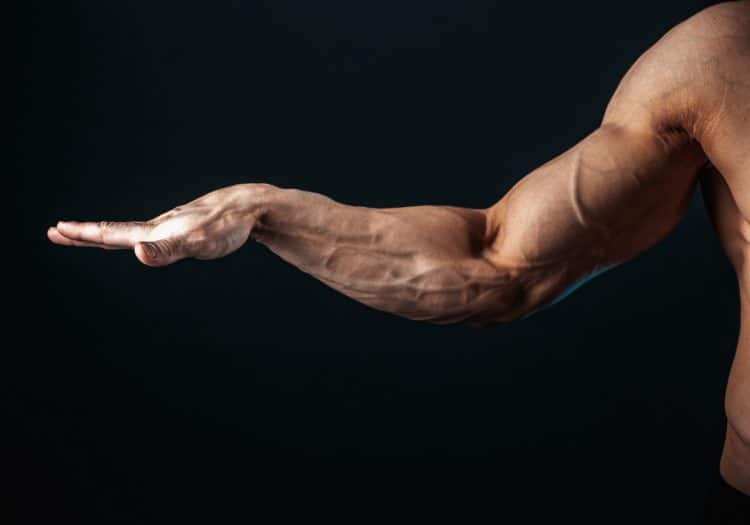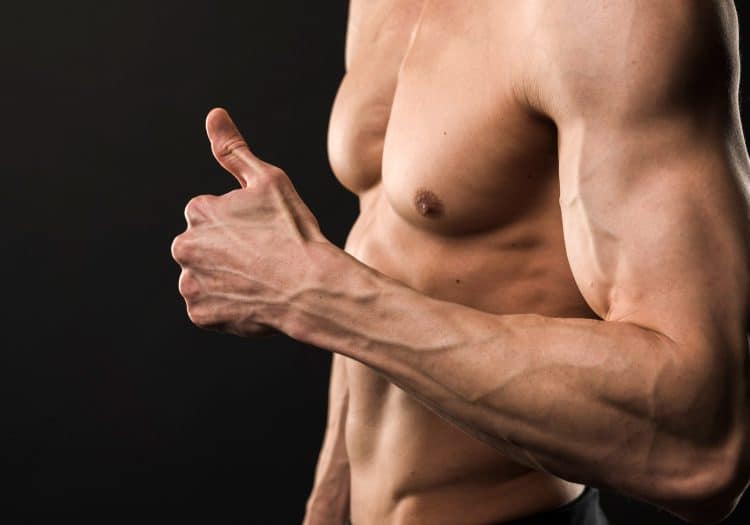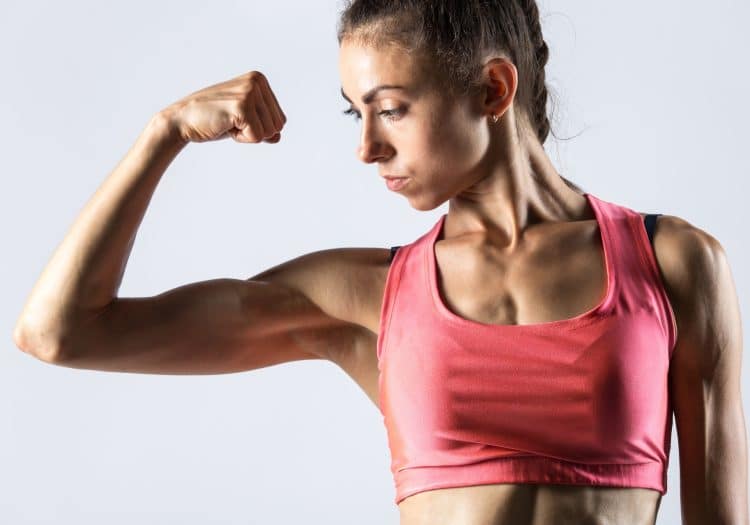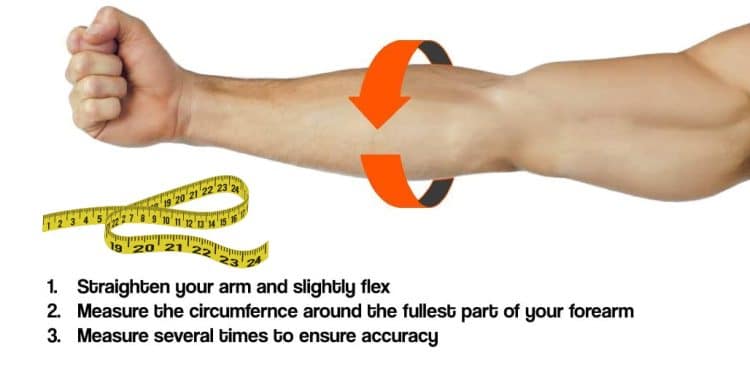Forearms are one of the most overlooked muscles, even though they are right under the most loved muscle group — the biceps. Developed forearms can add to your physique aesthetics and make you stand out by improving your symmetry, proportions, and balance.
Your forearms are constantly on display. Whether you wear a t-shirt to work or fold up your shirt sleeves, your lower arms are on exhibit. Even most folks with deadly pythons have underdeveloped forearms, and you would never know they work out if they didn’t flex their guns in tank tops on Instagram. On the flip side, a guy with thick and vascular forearms doesn’t have to put in the extra work; his gains are evident.
Bodybuilding enthusiasts know the importance of chiseled lower arms. The seven-time Mr. Olympia Phil Heath, Lee Priest, Flex Lewis, and Roelly Winklaar were unmatched in the forearm department. But yet, most lifters treat their forearms as accessory muscles and train them one to two times a month at best.
In this article, we explain the importance of knowing your forearm size, the average male and female lower arm size, the average length, how to measure your forearms correctly, factors affecting your lower arm size, and how to build bigger and stronger forearms.
There is a lot to cover. So, without any further ado, let’s dive into it.
Why You Should Know the Average Forearm Size


Besides the visual appeal, strong and muscular forearms can improve your physical performance in multiple ways. Your forearm muscles, especially the wrist flexors and extensors, are responsible for grip strength. They can help you lift heavy objects and hold onto them. Strong forearms also make opening jammed jar lids a cakewalk.
Powerful lower arms can improve your fine motor skills, such as typing, writing, and playing musical instruments, as the small muscles in the fingers and hands connect to the forearm muscles.
Furthermore, forearms stabilize the elbow and wrist joints during movements such as lifting weights or performing push-ups. Without support from forearms, these exercises can increase your risk of injury by putting excessive strain on the joints.
Knowing the average forearm size will help you determine how you compare to your peers. It will aid in finding and fixing discrepancies, helping you improve your physique aesthetics and performance.
Average Forearm Size in Men


The average male forearm size ranges between 9.9 inches and 11.7 inches. Notably, there is not enough verified anthropological reference data on this subject. [1][2]
The upper arm, chest, upper leg, shoulder, waist, hip, elbow, and knee circumference, and height, weight, age, and gender are usually used as reference points in anthropological studies. These factors are considered to be valid physical health markers, whereas forearm circumference isn’t believed to be a significant indicator of an individual’s overall health.
The average forearm size for males and females varies depending on age, height, weight, and body composition. Generally, taller people with a normal BMI have bigger forearms than their shorter counterparts in the same BMI and age group.
Must Read: Biggest Forearms in the World and How To Build Jacked Lower Arms
Average Forearm Size in Women


According to the Journal of Physical Therapy Science, the average female forearm size ranges between 9.3 inches and 10.5 inches. The discrepancy in the average female forearm circumference (1.2 inches) is significantly lesser than the male average (1.8 inches). It shows that the female forearm size stays relatively consistent across different age groups and BMIs. [3]
As with the males, the average female forearm size changes according to the participant’s age, weight, height, and body composition.
Interestingly, the dominant forearm is usually bigger than the other side. We typically lift objects with our dominant side, which can lead to building bigger muscles over time. This phenomenon also applies to the biceps. Your writing arm’s muscles are generally bigger than the other side.
Average Forearm Length
The length of your forearms can impact their overall size. According to a study, the average right forearm length in men ranged from 7.87 to 12 inches, and the left lower arm from 7.87 to 11.81 inches. On the other hand, the average right forearm length in women ranged from 7.5 to 12.2 inches and 7.5 to 13 inches for the left one. The average forearm length in men is 10 inches, whereas the average lower arm length in women is 9.25 inches. [4]
Interestingly, although men had longer forearms on average, women recorded a higher measurement in the upper end of the range. The longest measurement for the right forearm in males was 12 inches, whereas it was 12.2 for females. Similarly, 11.81 inches was the longest forearm on the male side compared to 13 inches for the women. Furthermore, the right forearm was longer than the left in both sexes.
The study also found that the length of the forearm decreased in relation to age in men, whereas it increased for women.
How To Measure Your Forearm Circumference Correctly
You will need a soft measuring tape and someone’s help to measure your forearms accurately. Here is how to measure your forearm size:
- To ensure precise measurements, you must measure the bare forearms.
- Have the subject place their arm at their side, straighten their arm, and slightly flex it. Their palm should face the wall in front of them.
- Wrap the measuring tape around the thickest part of the forearm.
- Record the number where the tape overlaps.


Notes:
- The measuring tape should be neither too loose, causing it to hang loosely around the forearm, nor too tight, causing it to dig into the skin.
- Take the measurement 2-3 times to ensure accuracy.
- Avoid clenching your fists, as it contracts your muscles and will skew the results.
- Measure both your arms.
Ideal Forearm Size
Ask the folks at your gym about the ideal (or their goal) biceps size, and they’ll most likely tell you that 20 inches is the magic number. However, ask them about the ideal forearm size, and they’ll ask you not to interrupt their set.


The ideal forearm size is very subjective. Nonetheless, Eugen Sandow, also known as the “Father of Modern Bodybuilding,” was obsessed with perfect physique proportions and spent countless hours visiting museums and measuring Greek statue proportions to devise his ideal physique blueprint. He called it the Grecian Ideal.
The Grecian ideal calculator provides an approximation of ideal muscle proportions based on your wrist circumference.
According to research, the average male wrist size is 6.85 inches. As per this data, the ideal forearm size for men will be 13 inches. On the other hand, the average women’s wrist size is 6 inches, and her ideal forearm size will be 11 inches. [5]
The Grecian Ideal allows you to estimate your chest, waist, hips, biceps, forearms, thigh, calves, and neck measurements. It was used by bodybuilding legends like Steve Reeves, Reg Park, Arnold Schwarzenegger, Frank Zane, Lee Labrada, and Serge Nubret.
Factors Affecting Forearm Size
The following factors affect your forearm size:
- Genetics: Genetics plays a crucial role in determining your muscle size, shape, and proportions.
- Age: Your forearm can get smaller as you grow older because of muscle loss or atrophy.
- Sex: As mentioned in this article, males generally have larger forearms than women due to higher testosterone levels.
- Exercise: Regular strength training can help build bigger forearms. Focus on forearm-specific exercises for building bigger lower arms.
- Nutrition: You must follow a balanced diet program to build muscle mass and strength. Switch to a high-protein diet to build new muscle tissue.
How To Increase Forearm Size — Workouts
Your forearm size is determined by your genetics, age, sex, and exercise and nutrition program. Although you can do little about the first three factors, you can tweak the last two to build stronger and bigger forearms.
Here is how to increase your forearm size with nutrition and exercise:
Nutrition
To build muscle mass, you must follow a high-protein diet. Begin by determining your daily calorie intake goal and breaking it down into suitable macronutrient targets. Each person’s diet program will vary depending on their lifestyle and metabolism. To build muscle, you must enter a calorie surplus, meaning you must eat more calories daily than you burn. Use our free calorie calculator and macronutrient calculator to set your nutrition goals. Furthermore, get expert help to expedite your transformation.
Training
Given below are two training programs for building bigger forearms:
Bodyweight Forearm Workout
You can build bigger and stronger forearms in the comfort of your home with this workout:
| Exercise | Sets | Reps |
| Dead Hang | 3-5 | 30-60 seconds |
| Towel Pull-Up | 3-5 | 8-12 |
| Inner Wrist Curl | 3-5 | 20-25 |
For the inner wrist curl, extend your arms in front of you; your palms should face the ceiling. Clench your fists and slowly curl your wrists while contracting your forearms.
Weighted Forearm Workout
Here is a weighted forearm workout to supercharge your lower arm gains:
| Exercise | Sets | Reps |
| Wrist Curl | 3-5 | 8-12 |
| Reverse Wrist Curl | 3-5 | 8-12 |
| Reverse Biceps Curl | 3-5 | 8-12 |
| Farmer’s Carry | 3-5 | 30-60 seconds |
| Pinch-Grip Plate Hold | 3-5 | 30-60 seconds |
Do these workouts 1-2 times weekly to improve your forearm game. Furthermore, forearms are a small muscle group; you must give your lower arms at least 48 hours of rest between workouts to optimize recovery.
Frequently Asked Questions
How to increase forearm vascularity?
Many people want to improve their forearm vascularity. You can achieve it by reducing body fat, building muscle mass, bumping up your cardio training, and using a vascular occlusion training (VOT) technique. You could also increase your forearm vascularity temporarily with nitric oxide supplements, such as L-arginine, L-citrulline, and beetroot extract. Note: consult your doctor before starting any new supplement, nutrition, or fitness routine.
Can body fat affect forearm circumference?
Yes, gaining subcutaneous fat (fat under the skin) can lead to a bigger forearm circumference. However, fat gain on your forearms is usually late and insignificant.
What is the average forearm length in men and women?
The average male forearm length is 10 inches, whereas the average female lower arm length is 9.25 inches. People with longer forearms usually have a bigger forearm circumference than their counterparts.
Also Check Out:
Wrapping Up
Developed forearms offer multiple benefits, including improved physique aesthetics, grip strength, fine motor skills, and joint stabilization. The two workouts in this article will help you build bigger and stronger forearms.
Remember, these average numbers are only meant to be guiding figures. You shouldn’t hang your head low if you are below the average marker. Each individual is built differently. Your forearm circumference depends on your genetics, age, gender, exercise, and nutrition regimen. Put in the work and be patient and persistent. Best of luck!
References
- Abe T, Thiebaud RS, Loenneke JP. Forearm muscle quality as a better indicator of physical performance than handgrip strength in older male ground golf players aged 70 to 89. J Musculoskelet Neuronal Interact. 2016 Dec 14;16(4):296-301. PMID: 27973381; PMCID: PMC5259570.
- Kilani H, Abu-Eisheh A. Optimum anthropometric criteria for ideal body composition related fitness. Sultan Qaboos University Medical Journal. 2010 Apr;10(1):74-79. PMID: 21509084; PMCID: PMC3074666.
- Abe, T., & Loenneke, J. P. (2015). Handgrip strength dominance is associated with differences in forearm muscle size. Journal of Physical Therapy Science, 27(7), 2147–2149. https://doi.org/10.1589/jpts.27.2147
- Zarzycka N, Załuska S. Pomiary przedramienia u ludności wiejskiej Lebelszczyzny [Measurements of the forearm i inhabitants of the Lublin region]. Ann Univ Mariae Curie Sklodowska Med. 1989;44:85-92. Polish. PMID: 2562693.
- MedlinePlus. (2020). Calculating body frame size.
